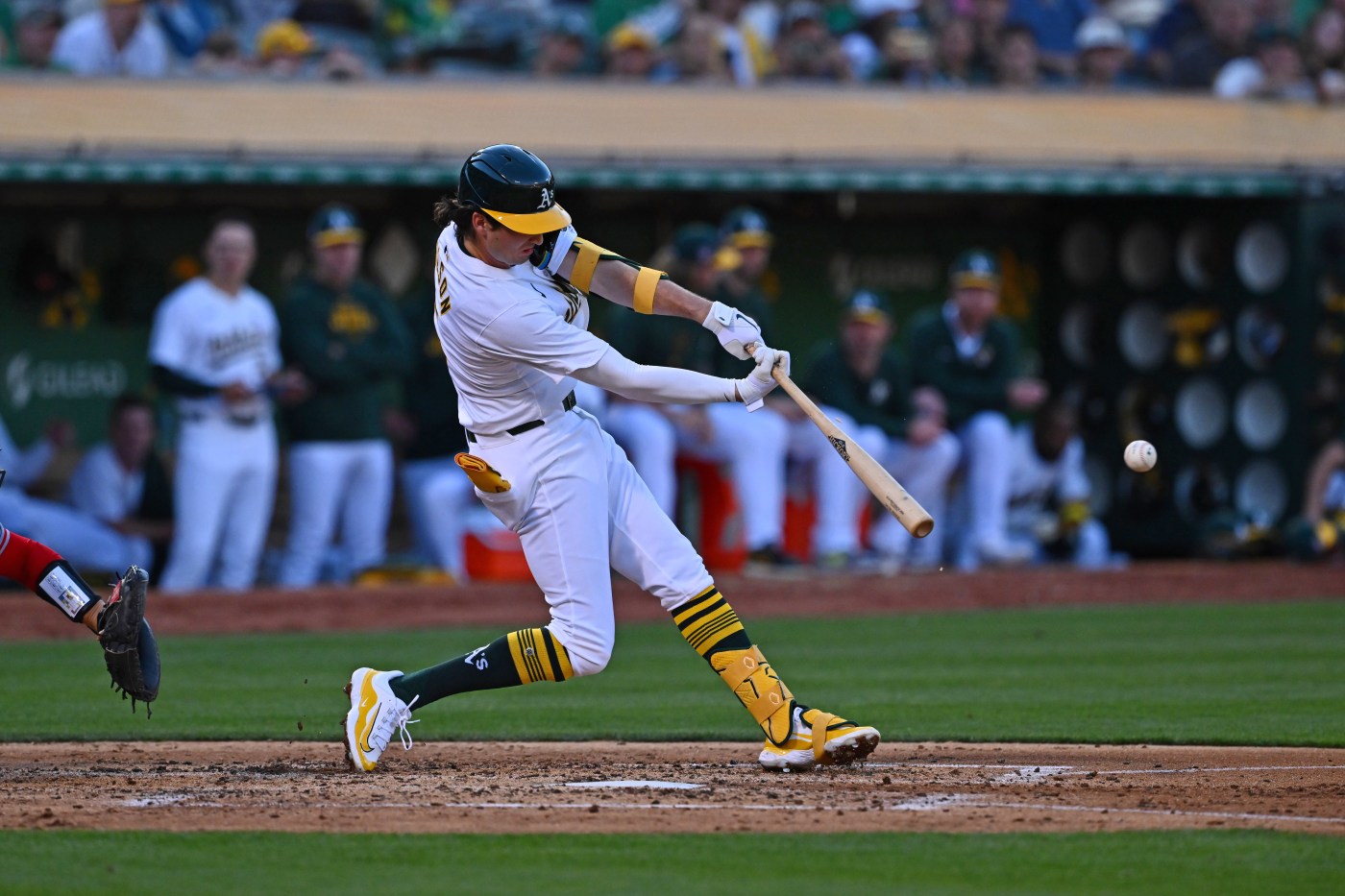Jacob Wilson the person is the antithesis of Jacob Wilson the batter.
Wilson the person is classic California cool. He’s chill. He’s low-key. His father, Jack, who spent 12 years in the majors, couldn’t help but notice how calm Jacob appeared before his debut.
Wilson the batter is akin to the Energizer Bunny on a double shot of espresso. He’s energetic. He’s jittery. He’s twitchy. His hands never stop moving, and his feet never stop bouncing. For Wilson, the A’s shortstop who owns a career .401 batting average in the minor leagues, this isn’t a bug — it’s a feature.
Mickey Hart, the longtime drummer of the Grateful Dead, once mused, “Life is about rhythm. We vibrate, our hearts pumping blood. We are a rhythm machine, that’s what we are.”
Wilson, 22, is just that: a rhythm machine. His mechanics, defined by perpetual motion and movement, are unconventional. His results, at least at the minor-league level, are undebatable.
First MLB hit for Jacob Wilson!! pic.twitter.com/VKzh3z9wGu
— Oakland A’s (@Athletics) July 20, 2024
“I pretty much designed it,” Jack said. “It was on purpose. I felt like when he started getting to a certain age and he was showing the ability to really swing the bat … I started looking back and thinking back to all the best hitters I played against and tried to kind of model his swing and his approach to the best guys that I played against.”
When Jack went about molding Jacob’s swing, he derived inspiration from three of the best right-handed hitters of all time, all of whom are destined for the Hall of Fame: Albert Pujols, Miguel Cabrera and Mike Trout.
Cabrera, for his ability to “get into his legs.”
“He was actually a very tall player, but when he would go to swing, when he would go into his load, he actually got pretty low,” Jack said.
Trout, for his ability to load his hands.
“Trout starts his hands over his heads, but then he does a leg kick, and when he lifts his leg, his hands go right back into his slot, which is his firing point,” Jack said. “I like the fact that he got his hands completely out of the way, so now, all he has to do is see the ball and place the bat on the ball.”
Pujols, for his swing path.
“We broke together in 2001, and his bat path was so on-path with all the balls for such a long period of time that I would actually lose the balls he hit on his bat because he used an all-natural bat, which was the same color as the baseball,” Jack said.
Related Articles
Trifecta of home runs power A’s to victory over Reds in Cincinnati
A’s top Brewers, spoiling return of former Oakland starter to Coliseum
‘Broccoli Guy’ explains his unique moves, why he traveled from Seattle to visit Oakland Coliseum
Bauers homers and scores 3 times to pace Brewers past Athletics, 9-5
Oakland A’s starter struggles in blowout loss to Milwaukee Brewers
“With my dad being a former player, he learned those things along the way when he played against different hitters, took all the information he got from those guys and taught them to me at a very young age,” Jacob said.
But as far as the pre-pitch twitch? That mechanic isn’t derived from Cabrera or Pujols or Trout. It isn’t even rooted in baseball.
Jack began taking boxing lessons for a couple years after his playing days, and he observed how boxers remained in constant motion. They never stopped moving their feet; they never stopped dancing. So, Jacob, too, would never stop moving.
“The fastest, most explosive athletes that I’ve seen are boxers,” Jack said. “The one thing that boxers do, they’re always moving their feet. So, they’re generating energy as they’re getting ready to punch. It all starts with the feet all the way up through the body. When he’s moving his feet in the box, he’s building energy in order to get everything that he has in his body to make that swing.”
“There are so many ways to skin a cat, right?” said A’s bench coach and director of hitting Darren Bush. “There’s no one particular way to hit. He has the ability to move and do things and find the barrel.”
Jacob’s pre-pitch twitch, from a purely aesthetic perspective, sticks out to any observer. Hitters, for the most part, are static creatures before a pitcher’s delivery. Some move their hands. Others may subtly raise the calves of their front foot (Trout does so). For all the movement, Wilson, more often than not, finds himself in the right spot to fire off a swing.
“As a hitting guy, for me, what you do before your front heel set down and you’re in a launch position … doesn’t really matter,” said Craig Conklin, the manager of Oakland’s High-A affiliate. “It’s all unique. It’s rhythm and timing and balance for that person, whatever they need to do to get things firing. Once they start and their front foot lands and their heel comes down and they’re ready to fire, that’s what’s important.”
“What you noticed is that he does that to get in rhythm, but by the time he lands and is ready to hit, he’s in a great, balanced position,” said Greg Wallis, Wilson’s coach at Grand Canyon University. “His barrel control and his hand-eye coordination were just elite from a young age.”
There hasn’t been a single level where Wilson’s approach hasn’t worked. He hit .361 in college, including .411 as a junior, before being picked with the sixth pick in the 2023 MLB Draft. He owns a .433/.473/.668 slash line in the minors this season. He, appropriately enough, lined a single into left field in his first major-league at-bat. Having finally returned from the left hamstring injury suffered in his debut, he’ll have an opportunity to prove if his bat plays in the big leagues, too.
“When you have good rhythm, you’re going to have good timing,” Jacob said. “For me, I’m a guy that likes to go super early. I feel like when I go super early, I see the ball longer. That’s just kind of my thing. I’ve always been a twitchy hitter like that. Timing is just a huge part of my game.”












